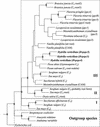Photosynthetic and other phosphoenolpyruvate carboxylase isoforms in the single-cell, facultative C(4) system of Hydrilla verticillata
- PMID: 12376652
- PMCID: PMC166614
- DOI: 10.1104/pp.008045
Photosynthetic and other phosphoenolpyruvate carboxylase isoforms in the single-cell, facultative C(4) system of Hydrilla verticillata
Abstract
The submersed monocot Hydrilla verticillata (L.f.) Royle is a facultative C(4) plant. It typically exhibits C(3) photosynthetic characteristics, but exposure to low [CO(2)] induces a C(4) system in which the C(4) and Calvin cycles co-exist in the same cell and the initial fixation in the light is catalyzed by phosphoenolpyruvate carboxylase (PEPC). Three full-length cDNAs encoding PEPC were isolated from H. verticillata, two from leaves and one from root. The sequences were 95% to 99% identical and shared a 75% to 85% similarity with other plant PEPCs. Transcript studies revealed that one isoform, Hvpepc4, was exclusively expressed in leaves during C(4) induction. This and enzyme kinetic data were consistent with it being the C(4) photosynthesis isoform. However, the C(4) signature serine of terrestrial plant C(4) isoforms was absent in this and the other H. verticillata sequences. Instead, alanine, typical of C(3) sequences, was present. Western analyses of C(3) and C(4) leaf extracts after anion-exchange chromatography showed similar dominant PEPC-specific bands at 110 kD. In phylogenetic analyses, the sequences grouped with C(3), non-graminaceous C(4), and Crassulacean acid metabolism PEPCs but not with the graminaceous C(4), and formed a clade with a gymnosperm, which is consistent with H. verticillata PEPC predating that of other C(4) angiosperms.
Figures

 , The Ser residue that is common to all plant
PEPCs and that is the target for phosphorylation; ●, the unique
Hvpepc4 Met residue;
, The Ser residue that is common to all plant
PEPCs and that is the target for phosphorylation; ●, the unique
Hvpepc4 Met residue;  , the F. trinervia
putative C4 Lys site; ○, the unique
Hvpepc5 Val; and ★, the position of the
C4 signature Ser.
, the F. trinervia
putative C4 Lys site; ○, the unique
Hvpepc5 Val; and ★, the position of the
C4 signature Ser.




Similar articles
-
Light regulation of the photosynthetic phosphoenolpyruvate carboxylase (PEPC) in Hydrilla verticillata.Plant Cell Physiol. 2006 Sep;47(9):1206-16. doi: 10.1093/pcp/pcj091. Epub 2006 Aug 27. Plant Cell Physiol. 2006. PMID: 16936335
-
Characterization of the NADP malic enzyme gene family in the facultative, single-cell C4 monocot Hydrilla verticillata.Photosynth Res. 2007 Oct;94(1):43-57. doi: 10.1007/s11120-007-9212-y. Epub 2007 Jul 19. Photosynth Res. 2007. PMID: 17638114
-
Identification of phosphoenolpyruvate carboxylase isoforms in leaf, stem and roots of the obligate CAM plant Vanilla planifolia Salib. (Orchidaceae): a physiological and molecular approach.Plant Mol Biol. 1998 Dec;38(6):1215-23. doi: 10.1023/a:1006006331011. Plant Mol Biol. 1998. PMID: 9869426
-
Evolution of c4 phosphoenolpyruvate carboxylase. Genes and proteins: a case study with the genus Flaveria.Ann Bot. 2004 Jan;93(1):13-23. doi: 10.1093/aob/mch003. Epub 2003 Nov 26. Ann Bot. 2004. PMID: 14644912 Free PMC article. Review.
-
The remarkable diversity of plant PEPC (phosphoenolpyruvate carboxylase): recent insights into the physiological functions and post-translational controls of non-photosynthetic PEPCs.Biochem J. 2011 May 15;436(1):15-34. doi: 10.1042/BJ20110078. Biochem J. 2011. PMID: 21524275 Review.
Cited by
-
Identification of C4 responsive genes in the facultative C4 plant Hydrilla verticillata.Photosynth Res. 2006 May;88(2):173-83. doi: 10.1007/s11120-006-9049-9. Epub 2006 Apr 19. Photosynth Res. 2006. PMID: 16622782
-
Characterisation of the phosphoenolpyruvate carboxylase gene family in sugarcane (Saccharum spp.).Theor Appl Genet. 2003 Aug;107(3):470-8. doi: 10.1007/s00122-003-1268-2. Epub 2003 May 21. Theor Appl Genet. 2003. PMID: 12759729
-
Transport and Use of Bicarbonate in Plants: Current Knowledge and Challenges Ahead.Int J Mol Sci. 2018 May 3;19(5):1352. doi: 10.3390/ijms19051352. Int J Mol Sci. 2018. PMID: 29751549 Free PMC article. Review.
-
Genome complexity in a lean, mean photosynthetic machine.Proc Natl Acad Sci U S A. 2006 Aug 1;103(31):11433-4. doi: 10.1073/pnas.0605255103. Epub 2006 Jul 25. Proc Natl Acad Sci U S A. 2006. PMID: 16868076 Free PMC article. No abstract available.
-
Underwater photosynthesis in flooded terrestrial plants: a matter of leaf plasticity.Ann Bot. 2005 Sep;96(4):581-9. doi: 10.1093/aob/mci212. Epub 2005 Jul 15. Ann Bot. 2005. PMID: 16024559 Free PMC article. Review.
References
-
- Björkman O, Pearcy RW, Nobs MA. Hybrids between Atriplexspecies with and without β-carboxylation photosynthesis: photosynthetic characteristics. Carnegie Inst Wash Year Book. 1970;69:640–648.
-
- Bläsing OE, Westhoff P, Svensson P. Evolution of C4 phosphoenolpyruvate carboxylase in Flaveria, a conserved serine residue in the carboxyl-terminal part of the enzyme is a major determinant for C4-specific characteristics. J Biol Chem. 2000;275:27917–27923. - PubMed
-
- Bowes G, Rao SK, Estavillo GM, Reiskind JB. C4 mechanisms in aquatic angiosperms: comparisons with terrestrial C4systems. Funct Plant Biol. 2002;29:379–392. - PubMed
-
- Bowes G, Salvucci ME. Plasticity in the photosynthetic carbon metabolism of submersed aquatic macrophytes. Aquat Bot. 1989;34:232–266.
-
- Bradford MM. A rapid and sensitive method for the quantification of microgram quantities of protein utilizing the principle of protein-dye binding. Anal Biochem. 1976;72:248–254. - PubMed
Publication types
MeSH terms
Substances
Associated data
- Actions
- Actions
- Actions
LinkOut - more resources
Full Text Sources
Miscellaneous

